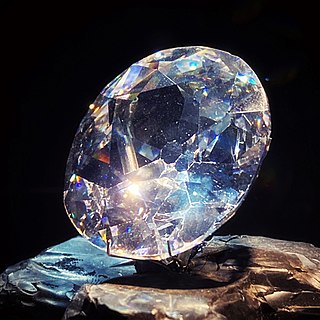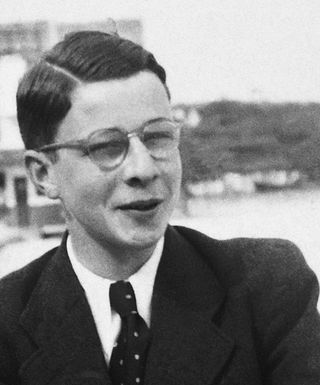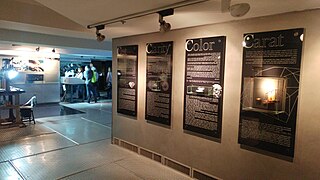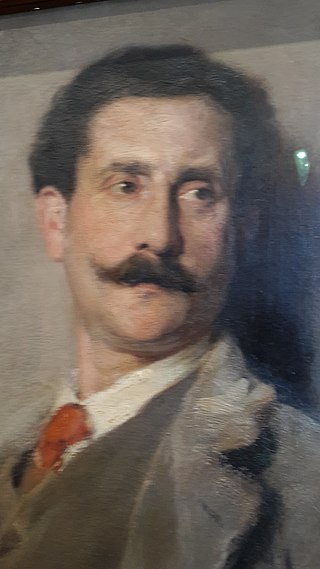Related Research Articles

The Koh-i-Noor, also spelled Koh-e-Noor,Kohinoor and Koh-i-Nur, is one of the largest cut diamonds in the world, weighing 105.6 carats (21.12 g). It is part of the Crown Jewels of the United Kingdom. The diamond is currently set in the Crown of Queen Elizabeth The Queen Mother.

Crown jewels are the objects of metalwork and jewellery in the regalia of a current or former monarchy. They are often used for the coronation of a monarch and a few other ceremonial occasions. A monarch may often be shown wearing them in portraits, as they symbolize the power and continuity of the monarchy. Additions to them may be made, but since medieval times the existing items are typically passed down unchanged as they symbolize the continuity of the monarchy.

A necklace is an article of jewellery that is worn around the neck. Necklaces may have been one of the earliest types of adornment worn by humans. They often serve ceremonial, religious, magical, or funerary purposes and are also used as symbols of wealth and status, given that they are commonly made of precious metals and stones.

The Peacock Throne was a famous jewelled throne that was the seat of the emperors of the Mughal Empire in India. It was commissioned in the early 17th century by Emperor Shah Jahan and was located in the Diwan-i-Khas in the Red Fort of Delhi. It was named after a peacock as two peacocks are shown dancing at its rear.

Boucheron is a French luxury jewelry and watch house located in Paris, 26 Place Vendôme, owned by Kering.
The fashioning of jewelry and the usage of precious jewels and metals under the Ming Dynasty was conducted by a select number of people in the occupation of jeweler. Typically born into the profession, jewelers worked in workshops and, using a myriad of techniques, creating many beautiful objects. They were primarily commissioned by the Royal Family and Royal court, although occasionally they created pieces for other members of the nobility or for Buddhist and Taoist temples. Adapting the system from the previous Yuan Dynasty, the Ming Dynasty mandated all artisanal professions, such as that of a jeweler, hereditary and binding from generation to generation. Beginning under the first Ming Emperor, the Hongwu Emperor, a complex system revolving around artisan craftsmanship developed in order to both fulfill the quotas imposed by the Ming Court as well as to protect the rights of the individual artisan and his family. Guilds and other partnerships also developed in order to protect the different artisans themselves. Within the Royal Court, there was also the Imperial Jewelry Service, which meant that there was both always some sort of official oversight over the jeweler profession as well as a steady demand for the labor of a jeweler.

Hans Stern was a Brazilian jeweler and businessman. He was dubbed the "king of the colored gems" by The New York Times and acclaimed by the international media. Founder of world-renowned luxury jewelry brand H.Stern.

The Maharaja of Indore Necklace is a diamond and emerald-studded necklace. As of 2008, it is on display at the National Museum of Natural History in Washington, D.C., United States. It was originally named the Spanish Inquisition Necklace by the American jeweller Harry Winston, though it had no known connection with the historical Spanish Inquisition. The name was changed in 2021 by the Smithsonian Institution to reflect its actual provenance, having been first owned by Tukoji Rao III, Maharaja of Indore in the early 20th century.

Regalia of the Russian tsars are the insignia of tsars and emperors of Russia, who ruled from the 13th to the 19th century. Over the centuries, the specific items used by Tsars changed greatly; the largest such shift occurred in the 18th century, when Peter the Great reformed the state to align it more closely with Western European monarchies.
Alexandre Reza was a Paris-based jeweler known for his diverse and rare collection of precious gemstones. He is lauded as the greatest gem collector of modern times.

Harry Oppenheimer Diamond Museum was a museum located in the Diamond Exchange District, Tel Aviv District city of Ramat Gan, Israel.

The Middle Ages was a period that spanned approximately 1000 years and is normally restricted to Europe and the Byzantine Empire. The material remains we have from that time, including jewelry, can vary greatly depending on the place and time of their creation, especially as Christianity discouraged the burial of jewellery as grave goods, except for royalty and important clerics, who were often buried in their best clothes and wearing jewels. The main material used for jewellery design in antiquity and leading into the Middle Ages was gold. Many different techniques were used to create working surfaces and add decoration to those surfaces to produce the jewellery, including soldering, plating and gilding, repoussé, chasing, inlay, enamelling, filigree and granulation, stamping, striking and casting. Major stylistic phases include barbarian, Byzantine, Carolingian and Ottonian, Viking, and the Late Middle Ages, when Western European styles became relatively similar.

The Portuguese crown jewels, also known as the Royal Treasure, are the pieces of jewelry, regalia, and vestments that were used by the Kings and Queens of Portugal during the time of the Portuguese Monarchy. Over the nine centuries of Portuguese history, the Portuguese crown jewels have lost and gained many pieces. Most of the current set of the Portuguese crown jewels are from the reigns of King João VI and King Luís I.

Ambaji Venkatesh Shinde was a prominent jewelry designer in New York.
George William Headley III was an American jewelry designer, collector, socialite and founder of the Headley-Whitney Museum in Lexington, Kentucky. As a designer, he was known for collaborations with Salvador Dalí, Paul Flato, David Webb and Cartier, between the 1920s and 1960s, with clients including Douglas Fairbanks, Gary Cooper, the Marx Brothers, Judy Garland and Joan Crawford, as well as for his extravagant bibelots - small, intricate and precious decorative objects.

Amrapali Jewels, is a jewellery house founded in 1978 by Rajiv Arora and Rajesh Ajmera in Jaipur. Amrapali designs, produces and distributes tribal, fine and uncut gemstone jewellery. The brand has stores in India and London. The brand also operates a museum of Indian jewellery in Jaipur.

Mughal clothing refers to clothing adhered by the Mughals in the 16th, 17th and 18th centuries throughout the extent of their empire. Much of them were already being used in the past centuries before their arrival in Indian subcontinent. It was characterized by luxurious styles and was made with muslin, silk, velvet and brocade. Elaborate patterns including dots, checks, and waves were used with colors from various dyes including cochineal, sulfate of iron, sulfate of copper and sulfate of antimony were used.
Prakash Chand Surana was an Indian jeweler, business person, philanthropist and a music connoisseur, known for his efforts to promote Hindustani music. He was the co-founder of Shruti Mandal, a music community in Jaipur and served as its president, under the aegis of which he reportedly attempted to revive Jaipur gharana tradition. Founded in 1964, the forum has hosted, over the years, such musicians as Kumar Gandharv, Ravi Shankar, Zakir Hussain, Bhimsen Joshi and Hariprasad Chaurasia. Born in 1939 in Jaipur in the Indian state of Rajasthan in a Marwari family, he inherited the family jewelry business and contributed to reviving the Kundan meenakari tradition of jewelry making. Surana, who was married to Shobha Devi and had four children- Chandra, Manju, Pracheer & Priti, died on 5 February 2015, succumbing to a cardiac arrest. The Government of India awarded him the fourth highest civilian honour of the Padma Shri, posthumously in 2016, for his contributions to arts. He was also a recipient of Sawai Bhawani Singh Award for excellence in business and industry and Dagar Gharana Award of the Maharana of Mewar Foundation.

Philippe Wolfers was a Belgian silversmith, jeweler, sculptor, medallist and designer. His mature work belongs to the Art Nouveau style, while in his later years his work aligned with Art Deco. As a jewel designer, he was less prolific than his French contemporary René Lalique. Nevertheless his "exemplaire unique" series of jewelry is among the finest jewelry created in Art Nouveau. Wolfers is also known for his sculptures, decorative objects and tableware executed in precious materials such as silver, bronze, ivory and marble. He also designed vases and objects in glass and faience.

Turkmen jewelry is a type of jewelry originating among the various Turkmen cultures of Western and Central Asia. The jewelry was crafted both for cosmetic and spiritual reasons, and the amount of jewelry an individual adorned themselves with was equated to the person's rank in society.
References
- ↑ "Munnu Kasliwal, the late owner of the Gem Palace". W Magazine.
- ↑ "Munnu Kasliwal". The Telegraph. 3 October 2012. Retrieved 19 February 2019.
- 1 2 Trebay, Guy (11 September 2012). "Munnu Kasliwal, a Favorite Jeweler of the Connoisseurs, Dies at Age 54". The New York Times.
- ↑ "Muriel Brandolini". (self).
- ↑ Trebay, Guy (11 September 2012). "Munnu Kasliwal, a Favorite Jeweler of Connoisseurs, Dies at 54". The New York Times.
- ↑ "Munnu's Collection for the Met". Munnu the Gem Palace.
- ↑ "Munnu Kasliwal". The Telegraph. Retrieved 24 January 2021.
- ↑ "SIddarharth Kasliwal Launches Handmade Jewelry Collection for Munnu the Gem Palace". Forbes.
- ↑ Lautman, Victoria; ContributorJournalist; author; lecturer (30 August 2012). "India's Lustre, Suddenly Dimmed: An Appreciation". HuffPost. Retrieved 24 January 2021.
{{cite web}}:|last2=has generic name (help)